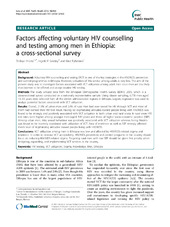| dc.contributor.author | Leta, Tesfaye Hordofa | en_US |
| dc.contributor.author | Sandøy, Ingvild Fossgard | en_US |
| dc.contributor.author | Fylkesnes, Knut | en_US |
| dc.date.accessioned | 2013-05-22T10:13:44Z | |
| dc.date.available | 2013-05-22T10:13:44Z | |
| dc.date.issued | 2012-06-15 | eng |
| dc.Published | BMC Public Health 2012, 12:438 | eng |
| dc.identifier.issn | 1471-2458 | |
| dc.identifier.uri | https://hdl.handle.net/1956/6644 | |
| dc.description.abstract | Background: Voluntary HIV counselling and testing (VCT) is one of the key strategies in the HIV/AIDS prevention and control programmes in Ethiopia. However, utilization of this service among adults is very low. The aim of the present study was to investigate factors associated with VCT utilization among adult men since men are less likely than women to be offered and accept routine HIV testing. Methods: The study utilized data from the Ethiopian Demographic Health Survey (EDHS) 2005, which is a cross-sectional survey conducted on a nationally representative sample. Using cluster sampling, 6,778 men aged 15–59 years were selected from all the eleven administrative regions in Ethiopia. Logistic regression was used to analyze potential factors associated with VCT utilization. Results: Overall, 21.9% of urban men and 2.6% of rural men had ever tested for HIV through VCT and most of them had learned their HIV test result. Having no stigmatizing attitudes toward people living with HIV/AIDS was found to be strongly and positively associated with VCT utilization in both urban and rural strata. In rural areas HIV test rates were higher among younger men (aged ≤44 years) and those of higher socio-economic position (SEP). Among urban men, risky sexual behaviour was positively associated with VCT utilization whereas being Muslim was found to be inversely associated with utilization of VCT. Area of residence as well as SEP strongly affected men’s level of stigmatizing attitudes toward people living with HIV/AIDS. Conclusions: VCT utilization among men in Ethiopia was low and affected by HIV/AIDS-related stigma and residence. In order to increase VCT acceptability, HIV/AIDS prevention and control programs in the country should focus on reducing HIV/AIDS-related stigma. Targeting rural men with low SEP should be given first priority when designing, expanding, and implementing VCT services in the country. | en_US |
| dc.language.iso | eng | eng |
| dc.publisher | BioMed Central | eng |
| dc.rights | Attribution CC BY | eng |
| dc.rights.uri | http://creativecommons.org/licenses/by/2.0/ | eng |
| dc.subject | HIV testing | eng |
| dc.subject | VCT utilization | eng |
| dc.subject | Stigma | eng |
| dc.subject | Ethiopia | eng |
| dc.title | Factors affecting voluntary HIV counselling and testing among men in Ethiopia: a cross-sectional survey | en_US |
| dc.type | Peer reviewed | |
| dc.type | Journal article | |
| dc.description.version | publishedVersion | en_US |
| dc.rights.holder | Copyright 2012 Leta et al.; licensee BioMed Central Ltd. | |
| dc.identifier.doi | https://doi.org/10.1186/1471-2458-12-438 | |
| dc.identifier.cristin | 941694 | |
| dc.source.journal | BMC Public Health | |
| dc.source.40 | 12 | |

